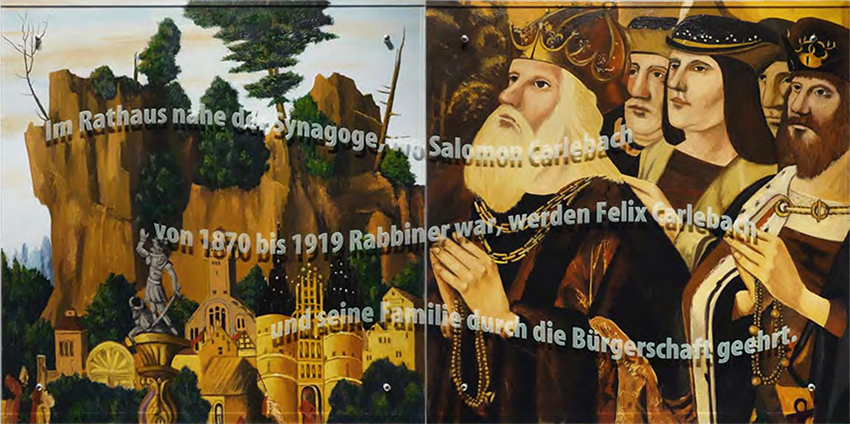Ken Aptekar, “Carlebach Küchentuch #5” (2015), oil/linen mounted on wood, sandblasted glass, bolts, 100cm x 200cm, (diptych). English translation: In the town hall near the synagogue, where Salomon Carlebach was Rabbi from 1870 to 1919, Felix Carlebach and his family are honored by the people of Lübeck. (from Nachbarn: Neighbors in a German Town)
” } –>
Ken Aptekar, “Carlebach Küchentuch #5” (2015), oil/linen mounted on wood, sandblasted glass, bolts, 100cm x 200cm, (diptych). English translation: In the town hall near the synagogue, where Salomon Carlebach was Rabbi from 1870 to 1919, Felix Carlebach and his family are honored by the people of Lübeck. (from Nachbarn: Neighbors in a German Town)
Nachbarn: Neighbors in a German Town, a solo exhibition by Pratt alumnus Ken Aptekar (M.F.A. ’75), opened on February 7 at the St. Annen Museum in the city of Lübeck in northern Germany, where it will be on view until May 29. Nachbarn, which is the German word for “neighbors,” draws from Lübeck’s long and complicated multicultural history to explore themes of tolerance, community, and “otherness.” Aptekar was commissioned by the museum to create the exhibition, which includes paintings, silverpoint drawings, and video. Aptekar and the exhibition have garnered media attention in a number of outlets, including a feature in The Guardian and coverage on German national public television.
Lübeck serves as the focal point for the broader themes and tensions explored in the exhibition. The Jewish population in Lübeck, which had lived alongside Christians for centuries, was decimated by the Holocaust. Starting in the 1990s, Russian Jews came to live in Lübeck, and Turkish Muslims now have a significant presence there, too, adding to the diversity of the town’s population. However, the atmosphere in Lübeck has remained charged, with several terrorist attacks targeting the Lübeck synagogue in the past two decades and anti-Muslim immigrant demonstrations on the rise.
Aptekar, whose art often combines painting with text, was commissioned by St. Annen’s director, Dr. Thorsten Rodiek, to consider Lübeck’s cultural history and Christian Lübeckers’ attitudes towards the Muslims and Russian Jews now living there. For Nachbarn, Aptekar incorporated images from the museum’s famed collection of medieval Christian altarpieces and overlaid them with text elements offering new messages from one neighbor to another, utilizing art history to highlight themes that have particular relevance in Europe and around the world today.
“I’ve observed a frightening rise in violent responses to otherness. Living in both Paris and New York has heightened my sense of urgency to respond to the Paris attacks of November 13 and Charlie Hebdo, and to the hateful rhetoric of politicians who exploit fear of others to grab power,” said Aptekar. “I saw in the history of this town in Germany a great opportunity for art to spark conversations across the cultural divide. My hope is that the exhibition will encourage peaceful, honest, and rewarding exchanges with our neighbors, whomever they may be.”
Aptekar received grants from the Memorial Foundation for Jewish Culture and the New York Foundation for the Arts/Artspire/Malka Fund to create the works on view at St. Annen, his first exhibition in Germany, whose presentation was supported by the Possehl Stiftung in Lübeck. He has also created commissioned works for museums including the Corcoran Museum in Washington, D.C.; the Victoria and Albert Museum in London; and the Musée Robert Dubois-Corneau in Brunoy, France.